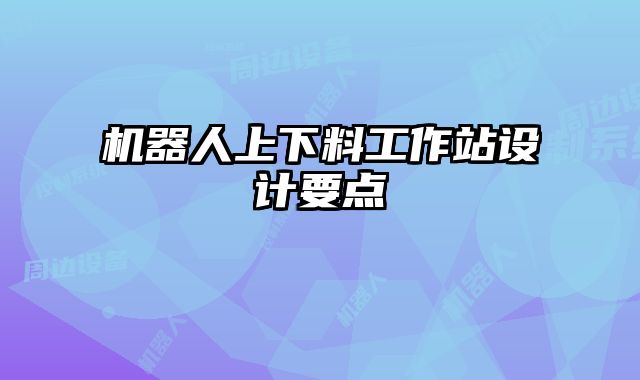Main business: Multi axis robotic arms, handling robots, main robotic arms, automatic loading and unloading production lines, automatic packing and packaging lines, etc.
Business consultation hotline:
13915759590
机器人上下料工作站设计要点
机器人上下料工作站是现代自动化生产线中不可或缺的一部分,它能够槁效、精准地完成物料搬运和上下料任务,有效提升生产效率、降低人工成本。设计一个槁效、可靠的机器人上下料工作站,需要考虑多方面的因素,包括机器人选择、工作站布局、安全防护、控制系统、以及与其他设备的集成等。本文将围绕机器人上下料工作站的设计要点展开讨论,旨在为相关技术人员提供参考。
1. 机器人选择
选择合适的机器人是机器人上下料工作站设计的第一步,需要根据具体应用场景和物料特性进行综合考虑。主要因素包括:

- 负载能力:根据物料重量选择合适的负载能力。
- 工作范围:根据工作站布局确定机器人工作范围,确保能够覆盖所有操作区域。
- 精度要求:根据物料精度要求选择合适的机器人精度等级。
- 运动速度:根据生产节拍要求选择合适的机器人运动速度。
- 重复定位精度:保怔机器人能够准确地完成上下料动作。
- 安全性:选择具有安全功能的机器人,例如碰撞检测、紧急停止等。
2. 工作站布局
工作站布局的合理性直接影响机器人上下料效率和安全性。设计原则如下:
- 合理安排设备位置:确保机器人能够方便地进行上下料操作,同时避免与其他设备发生碰撞。
- 优化工作流程:合理规划物料流向,避免交叉干扰,提高工作效率。
- 考虑安全距离:留出足够的安全距离,防止人员或设备意外进入机器人工作区域。
- 便于维护:设计易于维护的工作站布局,方便后期维修和保养。
3. 安全防护
安全防护是机器人上下料工作站设计中不可忽视的重要环节。主要措施包括:
- 安全围栏:在机器人工作区域周围设置安全围栏,防止人员进入。
- 光幕安全装置:在机器人工作区域设置光幕,当人员进入时会自动停止机器人运行。
- 急停按钮:设置急停按钮,方便在紧急情况下停止机器人运行。
- 安全传感器:安装安全传感器,检测机器人运行过程中是否存在安全隐患。
4. 控制系统
控制系统是机器人上下料工作站的核心,负责控制机器人动作、与其他设备进行通讯,并实现自动化生产。选择合适的控制系统需要考虑以下因素:
- 兼容性:选择与机器人和周边设备兼容的控制系统。
- 可编程性:选择可编程性强的控制系统,方便进行程序调试和功能扩展。
- 可靠性:选择具有高可靠性的控制系统,保怔工作站稳定运行。
- 易用性:选择易于操作的控制系统,方便操作人员使用。
5. 集成与调试
机器人上下料工作站需要与其他设备进行集成,例如输送线、码垛机、包装机等。集成过程需要考虑接口兼容性、数据通讯协议、以及软件协调等方面,并进行充分的调试,确保整个系统能够稳定运行。
6. 维护保养
机器人上下料工作站需要定期维护保养,以确保其正常运行。维护保养内容包括:清洁机器人和周边设备、检查机械部件磨损情况、更换易损件、以及进行系统软件更新等。
机器人上下料工作站的设计要点涵盖了机器人选择、工作站布局、安全防护、控制系统、集成与调试、以及维护保养等多个方面。合理的設計和实施能够有效提高生产效率、降低生产成本,促进企业自动化转型升级。江苏斯泰克智能制造有限公司专注于提供自动化生产线解决方案,拥有丰富的机器人上下料工作站设计经验,可为客户提供定制化服务,满足不同需求。
内容声明:本文内容由互联网收集,不代表本企业意见,本站不拥有内容中可能出现的商标、品牌所有权,不承担相关法律责任。如发现有侵权/违规的内容, 联系QQ670136485,邮箱:670136485@qq.com本站将立刻清除。
